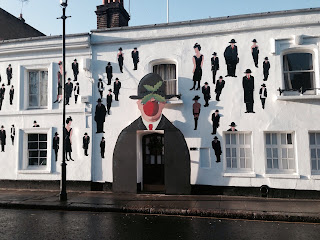I am in the mood for a Mark Doty poem tonight, so I found two, quite different ones. Happy Pride.
said
goodbye to his parents,
paid
off his credit card.
She
says Why don’t you just
run
it up to the limit?
but
he wants everything
squared
away, no balance owed,
though
he misses the pets
he’s
already found a home for
—
he can’t be around dogs or cats,
too
much risk. He says,
I
can’t have anything.
She
says, A bowl of goldfish?
He
says he doesn’t want to start
with
anything and then describes
the
kind he’d maybe like,
how
their tails would fan
to
a gold flaring. They talk
about
hot jewel tones,
gold
lacquer, say maybe
they’ll
go pick some out
though
he can’t go much of anywhere and then
abruptly
he says I can’t love
anything
I can’t finish.
He
says it like he’s had enough
of
the whole scintillant world,
though
what he means is
he’ll
never be satisfied and therefore
has
established this discipline,
a
kind of severe rehearsal.
That’s
where they leave it,
him
looking out the window,
her
knitting as she does because
she
needs to do something.
Later
he leaves a message:
Yes
to the bowl of goldfish.
Meaning:
let me go, if I have to,
in
brilliance. In a story I read,
a
Zen master who’d perfected
his
detachment from the things of the world
remembered,
at the moment of dying,
a
deer he used to feed in the park,
and
wondered who might care for it,
and
at that instant was reborn
in
the stunned flesh of a fawn.
So,
Maggie’s friend —
Is
he going out
Into
the last loved object
Of
his attention?
Fanning
the veined translucence
Of
an opulent tail,
Undulant
in some uncapturable curve
Is
he bronze chrysanthemums,
Copper
leaf, hurried darting,
Doubloons,
icon-colored fins
Troubling
the water?
Couture
1.
Peony
silks,
in wax-light:
that petal-sheen,
gold
or apricot or rose
candled into—
what to call it,
lumina,
aurora, aureole?
About gowns,
the Old Masters,
were
they ever wrong?
This penitent Magdalen’s
wrapped in a yellow
so
voluptuous
she seems to wear
all she's renounced;
this
boy angel
isn’t touching the ground,
but his billow
of
yardage refers
not to heaven
but to pleasure’s
textures,
the tactile
sheers and voiles
and tulles
which
weren’t made
to adorn the soul.
Eternity’s plainly nude;
the
naked here and now
longs for a little
dressing up. And though
they
seem to prefer
the invisible, every saint
in the gallery
flaunts
an improbable
tumble of drapery,
a nearly audible
liquidity
(bright
brass embroidery,
satin's violin-sheen)
raveled around the body’s
plain
prose; exquisite
(dis?)guises; poetry,
music, clothes.
2.
Nothing
needs to be this lavish.
Even the words I’d choose
for these leaves;
intricate,
stippled, foxed,
tortoise, mottled, splotched
—jeweled adjectives
for
a forest by Fabergé,
all cloisonné and enamel,
a yellow grove golden
in
its gleaming couture,
brass buttons
tumbling to the floor.
Who’s
it for?
Who’s the audience
for this bravura?
Maybe
the world’s
just trompe l’oeil,
appearances laid out
to
dazzle the eye;
who could see through this
to any world beyond
forms?
Maybe
the costume’s
the whole show,
all of revelation
we’ll
be offered.
So? Show me what’s not
a world of appearances.
Autumn’s
a grand old drag
in torched and tumbled chiffon
striking her weary pose.
Talk
about your mellow
fruitfulness! Smoky alto,
thou hast thy music,
too;
unforgettable,
those October damasks,
the dazzling kimono
worn,
dishabille,
uncountable curtain calls
in these footlights’
dusky,
flattering rose.
The world’s made fabulous
by fabulous clothes.


























.jpg)


